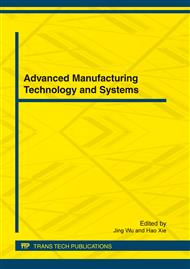p.146
p.151
p.156
p.160
p.165
p.170
p.176
p.181
p.186
Multi-Objective Optimization Strategy for Cutting Parameters Based on Controlling Face Milling Distortion
Abstract:
Machining distortion analysis and control are the kernel problem in manufacturing industry recently. This paper take face milling as research object, a finite element model for 3D milling process is set up based on some key techniques including cutter feed trajectories representations, cutter tooth-workpiece engagement model etc; Then the optimum LS-SVM model which can express the transitive relationship between cutting parameters and distortion error is set up; The cutting parameters optimization model based on controlling the machining distortion is founded by seeing the optimum LS-SVM model as the main objective function, meanwhile, an effective multi-objective optimization algorithm is proposed by coupling particle swarm algorithm and gray relevancy analysis, this algorithm can change the multi-objective optimization problem into optimizing the gray relevancy value effectively. As an example, the feasibility of proposed machining distortion controlling approach is verified.
Info:
Periodical:
Pages:
165-169
Citation:
Online since:
March 2012
Authors:
Price:
Сopyright:
© 2012 Trans Tech Publications Ltd. All Rights Reserved
Share:
Citation:


